Helena

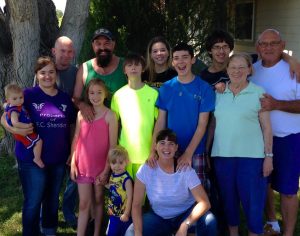 Our aunt, Charlys Schulenberg is all about family. She and Uncle Butch have three grown children, Tadd, Andi Kay, and Heath; as well as spouses and seven grandchildren. Their marriage has been very blessed, and Charlys is always happy when she gets to see her kids and grandkids. Unfortunately, their children don’t live in Forsyth, Montana where Aunt Charlys and Uncle Butch live, but thankfully they don’t live too far away…one in Helena, Montana and two in Sheridan, Wyoming. That kind of closeness means that they and easily plan for family gatherings, and I’m sure that makes everyone very happy.
Our aunt, Charlys Schulenberg is all about family. She and Uncle Butch have three grown children, Tadd, Andi Kay, and Heath; as well as spouses and seven grandchildren. Their marriage has been very blessed, and Charlys is always happy when she gets to see her kids and grandkids. Unfortunately, their children don’t live in Forsyth, Montana where Aunt Charlys and Uncle Butch live, but thankfully they don’t live too far away…one in Helena, Montana and two in Sheridan, Wyoming. That kind of closeness means that they and easily plan for family gatherings, and I’m sure that makes everyone very happy.
Aunt Charlys is such a sweet person, and a great blessing to be around…if you like being spoiled, and let’s be real, who doesn’t like being spoiled. The times Bob and I went to visit, I found out just what a great cook Aunt Charlys is. She and Uncle Butch have a lovely home in a senior community, that overlooks the Yellowstone River. That view is spectacular, and it inspires lots of pictures of stunning sunsets over the river. Not to mention 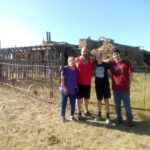
 many evenings sitting in the back yard watching the river go by as the sun sets. There is nothing more peaceful than that. They also have beautiful flower gardens, and a nice lawn that they really don’t have to mow, although I think Butch might mow sometimes. Their place is just such a lovely setting, and they feel so at peace there. Of course, they also have their vegetable garden, and from what I’ve seen, it looks pretty good…at least the past ones did. Each year is new and different, and I pray that they have a great crop this year.
many evenings sitting in the back yard watching the river go by as the sun sets. There is nothing more peaceful than that. They also have beautiful flower gardens, and a nice lawn that they really don’t have to mow, although I think Butch might mow sometimes. Their place is just such a lovely setting, and they feel so at peace there. Of course, they also have their vegetable garden, and from what I’ve seen, it looks pretty good…at least the past ones did. Each year is new and different, and I pray that they have a great crop this year.
While I have never met Aunt Charlys’ sister, Carol Hansell, who lives in Mississippi, but I love the relationship they have. Charlys, Butch, and Carol are always teasing each other, which reminds me of my own sisters and me. I love when siblings can joke around and make each other laugh, because let’s face it, you can never laugh too much. And siblings…well, they are priceless. It used to be that if you and your siblings were going to be very close, you needed to live near each other, but now with so many options on the internet, like Facebook, you can stay close, even over the miles. It makes me happy for Aunt Charlyn and her sister.
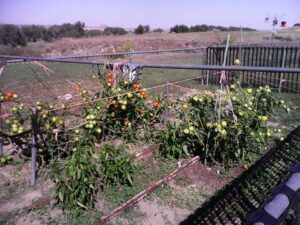

Even though we don’t get to see Aunt Charlys and Uncle Butch as much as we would like to, because we too live a way away from them. I always feel a closeness to them when we are there, or even when we are just having a Facebook conversation. They are both such friendly and welcoming people, and they make everyone feel really happy. Today is Aunt Charlys’ birthday. Happy birthday Aunt Charlys!! Have a great day!! We love you!!
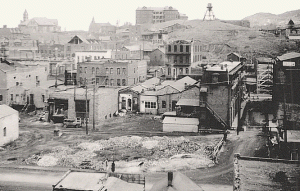 For many years my husband’s Aunt Marian and Uncle John Kanta lived in Helena, Montana. Some of their kids still do, but they didn’t live there in 1935, when on October 18th, a magnitude 6.2 earthquake struck at 10:48pm. The quake had its epicenter right near Helena and it had a maximum perceived intensity of VIII (Severe) on the Mercalli intensity scale. The quake on that date was the largest of a series of earthquakes that also included a large aftershock on October 31 of magnitude 6.0 and a maximum intensity of VIII. Two people died in the first quake, and two others died as a result of the October 31 aftershock. Property damage was over $4 million.
For many years my husband’s Aunt Marian and Uncle John Kanta lived in Helena, Montana. Some of their kids still do, but they didn’t live there in 1935, when on October 18th, a magnitude 6.2 earthquake struck at 10:48pm. The quake had its epicenter right near Helena and it had a maximum perceived intensity of VIII (Severe) on the Mercalli intensity scale. The quake on that date was the largest of a series of earthquakes that also included a large aftershock on October 31 of magnitude 6.0 and a maximum intensity of VIII. Two people died in the first quake, and two others died as a result of the October 31 aftershock. Property damage was over $4 million.
Helena is a pretty city that lies in a valley in western Montana. It lies within the northern part of the Intermountain Seismic Belt (ISB). I didn’t know it then, but this is an area of relatively intense seismicity. It runs from northwestern Arizona, through Utah, Idaho, and Wyoming, before dying out in northwestern Montana. In the area near Helena, it turns to the northwest, where it intersects with the Lewis and Clark fault zone. The Helena earthquake sequence actually began October 3, 1935, with a small earthquake. That quake was followed by a damaging earthquake on October 12th, a magnitude 5.9, intensity VII. That wasn’t the mainshock, however. That one occurred on October 18th, a magnitude 6.2, intensity VIII. A lesser shock followed on October 31st, a magnitude 6.0, intensity VIII, and a further large aftershock on November 28th, a magnitude 5.5, intensity VI. These were just the mainshocks. There were also a total of 1800 tremors recorded 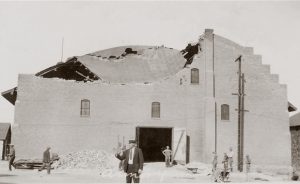 between October 4, 1935 and April 30, 1936. The people of Helena either got used to the shaking, which I can’t imagine, or they were terrified with every tremor, which makes more sense to me.
between October 4, 1935 and April 30, 1936. The people of Helena either got used to the shaking, which I can’t imagine, or they were terrified with every tremor, which makes more sense to me.
The damage to the unreinforced buildings of that era was widespread, with more than 200 chimneys destroyed in the city of Helena. At that time, little was known about reinforcement of buildings in earthquake prone areas. The northeast part of the city, where buildings were constructed on alluvial soil, and in the southern business district, which contained many brick buildings, saw the strongest effects. Alluvial soil is highly porous, which would explain the soil liquification that took place. The most extensively damaged building was the Helena High School, which was completed in August 1935 and had just been dedicated in early October. The school buildings, which had cost $500,000, had not been designed to be earthquake resistant. Another building that was totally destroyed and had to be rebuilt was the Lewis and Clark County Hospital. The October 18 earthquake caused an estimated $3 million of damage to property. The aftershock of October 31 caused further damage estimated at $1 million, particularly to structures already weakened by the October 18 shock. Two people were killed by falling bricks in Helena during the October 18 shock. Two brick masons died as while removing a brick tower during the October 31 aftershock.
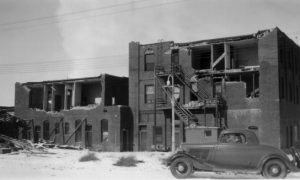 The Red Cross and Federal Emergency Relief Administration set up emergency camps for those displaced by the quake on land at the Montana Army National Guard’s Camp Cooney. Approximately 400 people stayed there the first night, but most had found space with friends or family outside of the damaged area by the end of the week. Some people were too afraid of continued shocks to stay in a house, and they stayed in tents for the next few weeks. The National Guard was deployed in Helena to keep sightseers away from the damaged buildings, and either because of the guard or the good moral values of the people, there was no looting. It is believed that in today’s world, the damages would have been in the $500 million range.
The Red Cross and Federal Emergency Relief Administration set up emergency camps for those displaced by the quake on land at the Montana Army National Guard’s Camp Cooney. Approximately 400 people stayed there the first night, but most had found space with friends or family outside of the damaged area by the end of the week. Some people were too afraid of continued shocks to stay in a house, and they stayed in tents for the next few weeks. The National Guard was deployed in Helena to keep sightseers away from the damaged buildings, and either because of the guard or the good moral values of the people, there was no looting. It is believed that in today’s world, the damages would have been in the $500 million range.
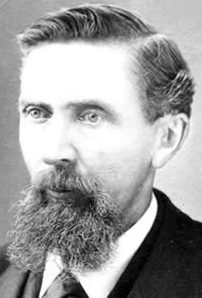 When Conrad Kohrs, immigrated to the United States at the age of 15, he was seeking his fortune like so many other immigrants were. The year was 1850, and while it is odd these days to think of a 15 year old boy immigrating to America alone now, it wasn’t entirely unheard of then. Kohrs was a native of Denmark, and had planned to head west to make his fortune in gold or silver. Unfortunately, while he had some small success in California and British Columbia, try as he might, the “big strike” always eluded Kohrs.
When Conrad Kohrs, immigrated to the United States at the age of 15, he was seeking his fortune like so many other immigrants were. The year was 1850, and while it is odd these days to think of a 15 year old boy immigrating to America alone now, it wasn’t entirely unheard of then. Kohrs was a native of Denmark, and had planned to head west to make his fortune in gold or silver. Unfortunately, while he had some small success in California and British Columbia, try as he might, the “big strike” always eluded Kohrs.
Kohrs tended to follow the crowd, and in 1862, he joined the latest western gold rush and headed for western Montana, where rich gold deposits had been found at Grasshopper Creek. It might be true that gold was plentiful at Grasshopper Creek, but Kohrs realized that he could make more money mining the miners than mining for gold. Miners need lots of supplies, and the man who was able to supply the needs, was the one who made money. He established a butcher shop in the mining town of Bannack and began to prosper.
His work as a butcher led Kohrs into the cattle business. Cattle were a big commodity, being in relatively short supply in frontier Montana. Much has changed today, and Kohrs had a big part in that. Kohrs traveled around the territory to purchase prime animals. He had several brushes with the highwaymen who plagued the isolated roads of Montana. Determined to stop these murderous bandits, Kohrs joined a group of Virginia City vigilantes, and helped track down and hang the outlaws. By 1864, robberies in the territory had plummeted. Proper or not, vigilante justice, got the point across very well.
Whether he was good at being part of a vigilante group or not, it couldn’t be what made his living. Kohrs began shifting the focus of his meat processing business to the supply side. In 1864, he established a large ranch near the town of Deer Lodge, where he fattened his cattle for market. Kohrs was pretty much the only major rancher in the western region of the territory. This caused his business to boom as Montana grew. As always happens, eventually, competition from cattle driven overland into the territory from Texas began to challenge Kohrs’ monopoly. Nevertheless, he continued to prosper, and remained the largest cattle rancher in Montana for several decades. 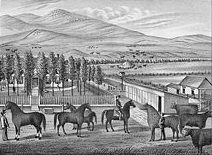
Kohrs entered the political arena in 1885, translating his economic strength into political power. He was elected to the Montana Territorial Legislature. Kohrs and his fellow ranchers had considerable influence over Montana in the years to come, and Kohrs went on to become a state senator in 1902. The big ranchers never had a free hand in Montana, however, because mining interests and farmers always kept the ranchers in check, but it wasn’t for a lack of trying. Kohrs was widely celebrated as one of the greatest pioneers in Montana history. He died on July 23, 1920 at the age of 85 in Helena.
 The discovery of gold in the United States triggered massive growth, with towns springing up across the area. Helena, Montana was one of those towns. On October 30, 1864, four miners struck it rich at their appropriately named mine, “Last Chance Gulch.” From that discovery came one of the wealthiest cities in the United States by the late nineteenth century…Helena, Montana. While it was once one of the wealthiest cities, the current population of Helena doesn’t really fall in line with the direction the city appeared to be taking in 1864. As of the 2010 census the population is 28,190, making it the fifth least populous state capital in the U.S after Montpelier, Vermont; Pierre, South Dakota; Augusta, Maine; and Frankfort, Kentucky.
The discovery of gold in the United States triggered massive growth, with towns springing up across the area. Helena, Montana was one of those towns. On October 30, 1864, four miners struck it rich at their appropriately named mine, “Last Chance Gulch.” From that discovery came one of the wealthiest cities in the United States by the late nineteenth century…Helena, Montana. While it was once one of the wealthiest cities, the current population of Helena doesn’t really fall in line with the direction the city appeared to be taking in 1864. As of the 2010 census the population is 28,190, making it the fifth least populous state capital in the U.S after Montpelier, Vermont; Pierre, South Dakota; Augusta, Maine; and Frankfort, Kentucky.
My husband, Bob Schulenberg’s aunt, Marion Kanta, and her family lived in Helena until the time for her passing in 1999, and many of her family members live there still. That said, we visited the capitol city a few times, and found it to be a very nice place. Of course, during the gold rush years, things might have been very 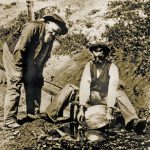 different. A gold rush town can have a tendency to be a high crime area, and when 3.6 billion dollars worth of gold is extracted in the city limits of a town over a twenty year period, you know that there were people who would like nothing more than to take over the claim of another person, no matter what it took. The first major Anglo settlement of Montana began in the summer of 1862, when prospectors found a sizeable deposit of placer gold at Grasshopper Creek to the west of what is today…Helena, Montana. When other even richer deposits were discovered nearby, a major rush began as tens of thousands of miners scoured the territory in search of gold. In 1864, four prospectors spotted signs of gold in the Helena area while on their way to the Kootenai country, but they were eager to reach the reportedly rich gold regions farther to the north and did not stop. Then, after striking out on the Kootenai, they decided to take “one last chance” on finding gold and returned. When the signs turned out to mark a rich deposit of placer gold, they staked their claims and named the new mining district Last Chance Gulch.
different. A gold rush town can have a tendency to be a high crime area, and when 3.6 billion dollars worth of gold is extracted in the city limits of a town over a twenty year period, you know that there were people who would like nothing more than to take over the claim of another person, no matter what it took. The first major Anglo settlement of Montana began in the summer of 1862, when prospectors found a sizeable deposit of placer gold at Grasshopper Creek to the west of what is today…Helena, Montana. When other even richer deposits were discovered nearby, a major rush began as tens of thousands of miners scoured the territory in search of gold. In 1864, four prospectors spotted signs of gold in the Helena area while on their way to the Kootenai country, but they were eager to reach the reportedly rich gold regions farther to the north and did not stop. Then, after striking out on the Kootenai, they decided to take “one last chance” on finding gold and returned. When the signs turned out to mark a rich deposit of placer gold, they staked their claims and named the new mining district Last Chance Gulch.
Last Chance Gulch would prove to be the second biggest placer gold deposit in Montana, producing some 19 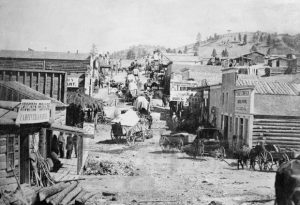 million dollars worth of gold in just four years. Almost overnight, thousands of miners flooded into the region, and the four original miners added to their fortunes by establishing the town of Helena to provide the new miners with food, lodging, and supplies. But unlike many of the early Montana mining towns, Helena did not disappear once the gold gave out, which was inevitable. Helena was able to survive and grow by serving the wider Montana mining industry, because it was located on several major transportation routes, well supplied with agricultural products from an adjacent valley, and near to several other important mining towns. In 1875, the city became the capital of Montana Territory, and in 1894, the capital of the new state of Montana.
million dollars worth of gold in just four years. Almost overnight, thousands of miners flooded into the region, and the four original miners added to their fortunes by establishing the town of Helena to provide the new miners with food, lodging, and supplies. But unlike many of the early Montana mining towns, Helena did not disappear once the gold gave out, which was inevitable. Helena was able to survive and grow by serving the wider Montana mining industry, because it was located on several major transportation routes, well supplied with agricultural products from an adjacent valley, and near to several other important mining towns. In 1875, the city became the capital of Montana Territory, and in 1894, the capital of the new state of Montana.
 When our girls were little, Bob and I took them to Helena, Montana to visit he Aunt Marion’s family. Aunt Marion was Bob’s dad’s older sister. She and her husband John lived in Helena with their 8 children. Bob and I had not gone to see them since our marriage, and we were on our way to visit his mother’s grandmother, so we decided to take a couple of days to visit Aunt Marion and her family too. It was September and the weather can be unpredictable.
When our girls were little, Bob and I took them to Helena, Montana to visit he Aunt Marion’s family. Aunt Marion was Bob’s dad’s older sister. She and her husband John lived in Helena with their 8 children. Bob and I had not gone to see them since our marriage, and we were on our way to visit his mother’s grandmother, so we decided to take a couple of days to visit Aunt Marion and her family too. It was September and the weather can be unpredictable.
We were going to run a couple of errands, and the sky was clouding up. Aunt Marion suggested that we leave the girls at the house in case it rained. So we headed out to the store. We completed our shopping much more quickly without two babies to carry too, so we were thankful that Aunt Marion had offered, and of course, her kids were excited about having some time to play with their little cousins too. And our girls were having such a good time when we left, that we knew they would be fine with it.
Nevertheless, I had an uneasy feeling as the sky got more and more black and the clouds began to look menacing. As we finished up our errands and headed back to Aunt Marion’s house, the lightning and thunder began. The weather almost reminded me of tornado weather, and I definitely didn’t like that. As we pulled up to Aunt Marion’s house their was a flash of lightning directly in front of us. The lightning hit the power line in front of her house, and literally danced along the power line for several seconds. I had never seen anything like it. Now I had a new dilemma. To go into the house…under that power line, or to stay in the car and leave my babies 
in the house with that monstrous lightning storm threatening my girls. I knew it was unreasonable. The girls were in no danger, but I just couldn’t get past the obstacle that stood between me and my girls.
Of course, everything was fine in the house, and I was just being silly, but I can tell you this. Seeing lightning strike…in any of the dramatic forms that can take, is something that you never forget, and to this day I can still see it in my mind. That has been 35 years ago, and I have never seen lightning strike in front of me again, something I can honestly say I’m not sorry about, but I will never forget the day in Helena, Montana when I did.

